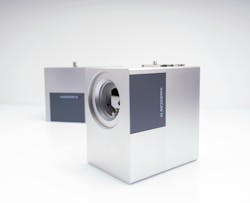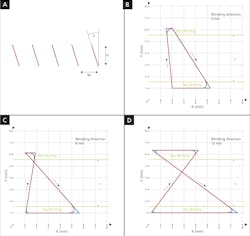High-speed battery foil laser cutting improves productivity in tabless battery manufacturing
The battery industry is driven by the need to balance technological innovation with reducing costs. Next-generation electric mobility vehicles require batteries with higher power and energy density, while simultaneously lowering material and manufacturing costs. To date, lithium-ion batteries dominate the automotive sector; tabless large cylindrical batteries are expected to gain market share, thanks to their higher energy density and enhanced power achieved via innovative designs.
Larger cell batteries
One approach to boost power in new electric vehicles is to increase the battery cell size. In 2020, Tesla unveiled a patent for a tabless electrode design, which is a large cylindrical cell form they call “the 4680 format.” Its inner volume is about 120 milliliters, which is far smaller than another approaches with blade cells (with a length of almost 1 meter and a volume of slightly less than 1.2 liters). But its form factor as a large cylindrical battery offers far more flexibility for the design of battery packs, for example, with parallel connections.
The 4680 battery, which has a diameter of 46 mm and a height of only 80 mm, is a design solution to optimize battery properties, battery pack design, and e-mobility design aspects. Conventional batteries feature an anode and a cathode tab (see Fig. 1a), which are in contact with the battery cover to achieve current flow. Tabless batteries are a full-flag design, as illustrated in Figure 1b. The tab extends along the entire battery foil, with a slit cut between each flag.
Tabless technology offers two key advantages to increase the energy density of the battery pack. First, as the electron flow path is shortened, the heat dissipation area from flags increases—and this enhances heat management and thermal stability, which improves overall safety. Second, tabless design reduces internal battery resistance and increases the electron flow speed, so it speeds its charging performance. Compared to the earlier 21700 blade batteries, the 4680 battery reportedly offers 5x more energy, 6x more power, and 16% more power range.
Production requirements for tabless batteries
Dry coating simplified the coating process in the Tesla's battery foil production by eliminating wet processes, which also increased production throughput. The benefit for the e-mobility industry is evident: Shorter coating production cycles enable the throughput to be adopted by other processes like battery foil cutting.
While the 4680 battery is a reference model of tabless battery design, full-flags require different geometries and cutting patterns compared to previous battery models. As for tabless design, the total number of cuts is increased, which makes higher dynamics and high-precision cutting essential for efficient battery foil production. This is why laser cutting is widely applied for modern battery manufacturing and has replaced the conventional knife cut.
For tabless-battery production, laser cutting with a galvanometer-based scan system is the most suitable solution because the cutting processes need to be fast and precise—while maintaining optimum cutting quality.
To achieve excellent cutting results, users need to consider and define several process parameters carefully: Cutting speed, the spot size, the laser specifications for wavelength, power, pulse energy, pulse length, and repetition rate.
Customized machine setup for laser cutting of battery foils
SCANLAB offers a wide variety of scanning solutions and control technology, and our intelliSCAN IV scan head (see Fig. 2) was developed for high-dynamic scanning. Its dust-proof housing features a cooling concept tailor-made for industrial use.
Users can choose to operate this scan head with SCANahead control to increase dynamics further and to use the SCANmotionControl trajectories and simulation software to predefine optimized process parameters. If combined with an RTC6 control board, maximum flexibility and other features like on-the-fly (OTF) mode or sky-writing (for perfect corners) are available.
OTF processing is of special interest for e-mobility and battery foil production, for example, to process moving parts on a conveyor belt, rotating plate, or in a roll-to-roll process. Its smart control board adjusts the laser scanner movement in reference to the relative workpiece position either indirectly by encoder counters or directly through a multichannel buffered serial port (MCBSP) interface.
If the OTF correction is active, the coordinate values of all vector and Arc commands are transformed with a scaling factor based to ensure precise processing. For applications with high accuracy requirements, sky-writing can be switched on. This functionality ensures that every mark vector is precisely executed at a constant mark speed over the entire vector length; for example, to allow fine corner cutting.
Simulation software shortens process development
Setting the optimum process parameters for new processing tasks can be time-consuming. But our SCANmotionControl software simulates the scan paths of lasers offline before the real processing. It takes the physical properties of the scan systems into account, which helps to define the parameters exactly upfront. What you simulate is what you get.
In reference to the tabless geometry published by Tesla in their patent for the 4680 battery (see Fig. 3), the simulation analyzed various scanner and conveyor belt speeds for an intelliSCAN IV 14 scan head equipped with an F-theta lens with f = 340 mm.
Simulations showed that setting bidirectional vertical cuts into flags increases the cutting efficiency. The best variant result was to set the mark and jump speed to the same value of 12 m/s to avoid unnecessary acceleration phases. Roll-to-roll speed was simulated for 3, 6, and 12 m/s, but higher foil speeds resulted in larger corner rounding. Quality requirements define the adequate foil speed. Afterward, the mark and jump speed can be increased further to optimize the process and the overall throughput.
Trajectory planning visualizes the target position (blue) and the simulated scanning results (red) with different belt speeds (see Fig. 4b-d). The exact size of the laser cutting process is marked between the two green dashed lines, and sky-writing is activated outside of them. During the latter process, the laser is switched off. The maximum conveyor belt speed depends primarily on the maximum image field size applied for the application. In a processing example for a belt speed of 12 m/s, a maximum image field width of approximately 8 mm is needed. The software allows both the belt speed and the scanner movement to be taken into consideration, so the best results in throughput and precision are achievable.
Up to 12 m/s belt speed, the flag cuts show a nondeformed and straight cutting quality. Our scanner allows for conveyor belt speeds far beyond commonly used belt speeds of 5–10 m/s. Even for complex geometries, the scan system ensures excellent cutting performance at the highest belt speeds, which makes it a suitable system for the demanding requirements of battery production.
Outlook
One area of interest on the horizon is multi-pulse lasers with “burst mode” operation. Cutting with multi-pulse burst mode provides distinct advantages over single-pulse processing. Burst mode increases the ablation rate and results in better cutting quality, which enables throughput increases. SCANLAB's advanced control electronics already enable a burst mode to be activated if the laser is equipped with it. Or, alternatively, the control board can trigger pulses at repetition rates up to 32 MHz while adjusting the half period parameter and the pulse length parameter to define desired pulse envelopes.
About the Author
Huihong Qian
Huihong Qian is in business development at SCANLAB (Puchheim, Germany).
Daniel Reitemeyer
Daniel Reitemeyer is in business development at Scanlab GmbH (Puchheim, Germany).



